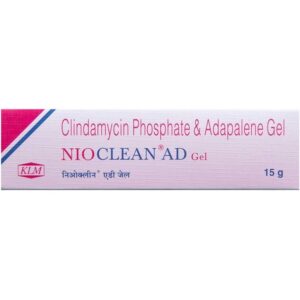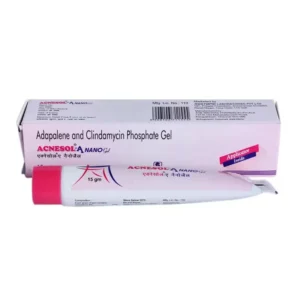ADAPALENE + CLINDAMYCIN
Adapalene: Adapalene is a medication used for the treatment of acne. It belongs to a class of drugs known as retinoids and is available in both topical gel and cream formulations. Adapalene is primarily used to treat mild to moderate acne by reducing the formation of comedones (blackheads and whiteheads) and reducing inflammation.
The mechanism of action of Adapalene involves normalizing the differentiation of follicular epithelial cells, which helps prevent the formation of comedones. It also has anti-inflammatory effects, reducing redness and swelling associated with acne.
For topical use, Adapalene is typically applied once daily, in the evening, on clean and dry skin. A thin layer should be gently rubbed into the affected areas. It is important to avoid contact with the eyes, lips, nostrils, and mucous membranes.
Common side effects of Adapalene include dryness, redness, itching, burning, and peeling of the skin. These side effects are usually mild and resolve on their own as the skin gets used to the medication. It is recommended to start with a lower concentration and gradually increase as tolerated to minimize skin irritation.
Less common, but more severe side effects can include severe irritation, allergic reactions, and skin discoloration. If any of these occur or if there is no improvement in acne after 8-12 weeks of treatment, a healthcare professional should be consulted.
Adapalene should not be used during pregnancy, as it may cause harm to the unborn baby. It is also not recommended for use in children under 12 years of age without medical supervision.
Clindamycin: Clindamycin is an antibiotic drug primarily used to treat bacterial infections. It belongs to the class of drugs known as lincosamides and is available in various forms, including capsules, oral solution, topical solution, gel, foam, and injection.
The primary use of Clindamycin is to treat infections caused by susceptible bacteria. It is commonly prescribed for skin and soft tissue infections, respiratory tract infections, bone and joint infections, intra-abdominal infections, and pelvic infections, among others. It may also be used in combination with other medications to treat severe infections.
The mechanism of action of Clindamycin involves inhibiting protein synthesis in bacteria. It binds to the 50S subunit of the bacterial ribosome, thereby preventing the addition of new amino acids to the growing peptide chain, leading to the inhibition of bacterial growth and reproduction.
The dose of Clindamycin depends on the type and severity of the infection, as well as the patient’s age, weight, and overall health. It is typically prescribed as 150-450 mg every 6-8 hours for oral administration, while the intravenous dosage ranges from 600-2700 mg per day divided into multiple doses. The topical forms are applied directly to the affected area as directed by the healthcare provider.
Like any medication, Clindamycin may cause certain side effects. Common side effects include diarrhea, nausea, vomiting, stomach pain, rash, and changes in taste. More severe but rare side effects may include severe allergic reactions, severe diarrhea (possibly indicating the development of Clostridium difficile-associated diarrhea or colitis), jaundice, and liver problems. It is important to promptly inform a healthcare provider if any unusual or severe side effects occur.
It is crucial to complete the full course of antibiotics as prescribed by the healthcare professional, even if symptoms improve before the course is finished. This helps to ensure that the infection is completely eradicated and reduces the risk of antibiotic resistance.






